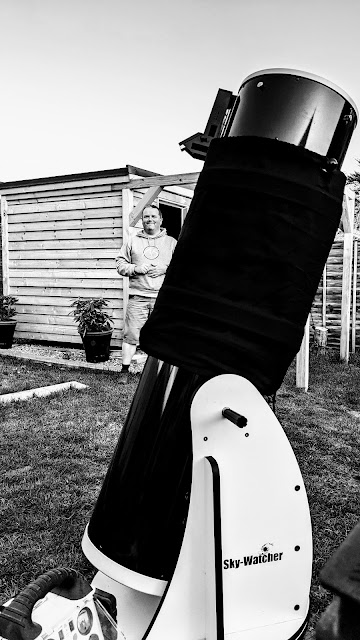34 Observations
34 Observations
In this second post of the present glut of posts, I wanted to go back to the days when my astro hobby was purely visual. With the weather being very kind recently, I've been able to set the imaging equipment up, but also set up the SBT in the back garden so while the imaging rig is running for 3 or 4 hours at a time, I've been able to get outside and use the Mk. 1 eyeball. It's been brilliant! It's been part of the hobby that doesn't get revisited too often, but boy is it rewarding!
13th April 2020
There's a familiar buzz when everything set up and you can't wait to get going. All you need to do is wait for darkness. The anticipation of seeing things which you don't get to observe very often is great. It's different to imaging, where, to be honest, you get a very different experience of what you're observing. Images very rarely, if ever, resemble anything that you see from the eyepiece. Observations are often just very dim smudges of light, and it becomes a bit of an art tracking them down and then picking out the detail as you spend your time at the eyepiece. It requires a lot more skill to locate them and observe, rather than just pushing a few buttons and performing a few mouse clicks on the computerised GoTO mount I have in the observatory. You could liken it to navigating in the mountains by traditional map, versus opening your phone, and using it as a GPS on a pre-planned route. Fortunately, I don't think visual observing with manual mounts is a dying art, unlike more traditional navigation techniques.
 |
| The SBT 12" dob set up in the garden waiting for darkness with the observatory in the background all prepped and ready to go. |
15th April
The weather during the day had been dry, warm and settled. No real cloud to speak of and relatively low humidity. It was all set up for a night of excellent conditions with local sky conditions as good as they will get. Having concentrated on the Messier objects, and galaxies in particular, for this second session, I wanted to observe some of the less popular objects. With the added bonus of moonless nights, the sky was truly dark at the moment. |
| Observing in full flow, using the red torch for picking through my star charts. |
The Broken Heart Cluster, The Spindle Galaxy and NGC 2403 were a few of the 11 targets I observed during the evening. Some of them harder to locate, and needing the use of a UHC filter to pick them out from the background sky meant that the tick list for the evening wasn't as long as the previous session, but in no means any less rewarding.
To finish the evening off, a reminder that the astronomical sky is ever changing. It only seems like a couple of weeks since we were welcoming galaxy season into our night sky, but now, by the time it gets dark truly dark, Leo is already touching the meridian and Virgo is well up in the sky. A sign that the sky never stands still. By the time I called it a night, Cygnus and Lyra were well up over the horizon giving a tantalising glimpse of what is to come. Unfortunately, in the coming couple of months, we will start to lose true astronomical darkness as we approach periods of the longest day light. It will mean that imaging sessions will be limited, and observing sessions short and possible for only a couple of hours very late into the night. Then, it will be time to step back for a month or so, until darkness returns. Who knows what the world will look like by July or August, but by then Leo and Virgo will be heading under the horizon by the time is gets dark, and Cygnus will be in prime position.
For me, during this quiet time, it will be the start of a maintenance period. There will be eyepieces to clean and service, mirrors to assess and if required, cleaned and the mount will be taken off the pier and cleaned up. It will also be the first period of maintenance for the observatory, All the wood will be treated and the inside will get a good clean out, ready for when darkness returns.
Thanks for reading. Next up, ISS solar transit imaging!


Comments
Post a Comment